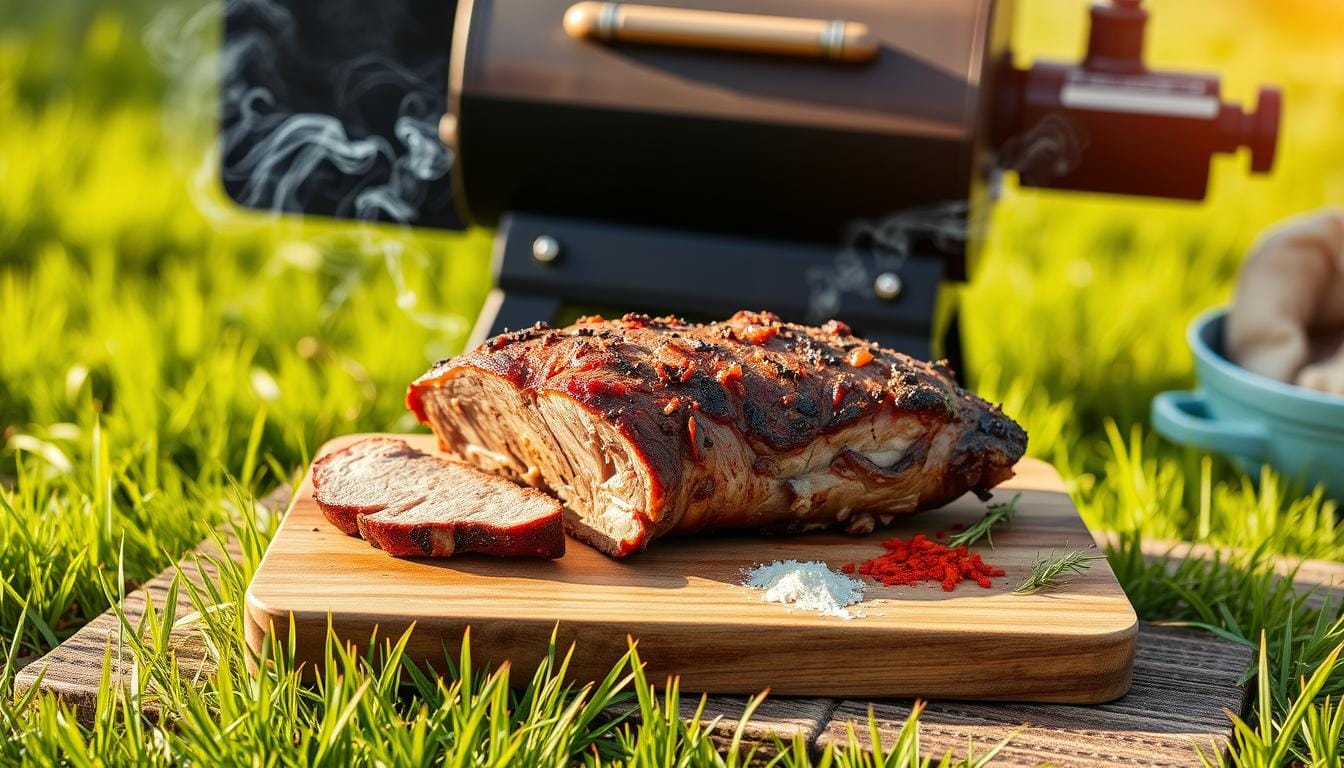Beef Brisket: The Ultimate Guide to Cooking & Enjoying
The first time I pulled a perfectly smoked beef brisket from my smoker, I knew something magical had happened. The rich aroma of slow-cooked meat filled the air. The deep mahogany bark and the promise of tender, melt-in-your-mouth texture made our cookout unforgettable.
Whether you’re a backyard BBQ enthusiast or a Texas-style brisket novice, this guide will help you every step of the way. You’ll learn how to select the right cut and master smoking techniques. Discover the secrets that make good BBQ brisket truly exceptional.
Cooking beef brisket is more than following a recipe. It’s about understanding the craft, respecting the meat, and embracing a tradition. This tradition connects generations of home cooks and professional pitmasters. Get ready to elevate your BBQ skills and impress everyone at your next gathering.
By the end of this guide, you’ll have the knowledge and confidence to turn a tough cut of meat into a tender, flavorful masterpiece. Your friends and family will be asking for seconds.
Table of Contents
Understanding Beef Brisket: Cuts, Grades, and Selection
Exploring beef brisket can make your cooking better. This guide will help you learn about brisket cuts, grades, and how to pick the best one for your next barbecue.
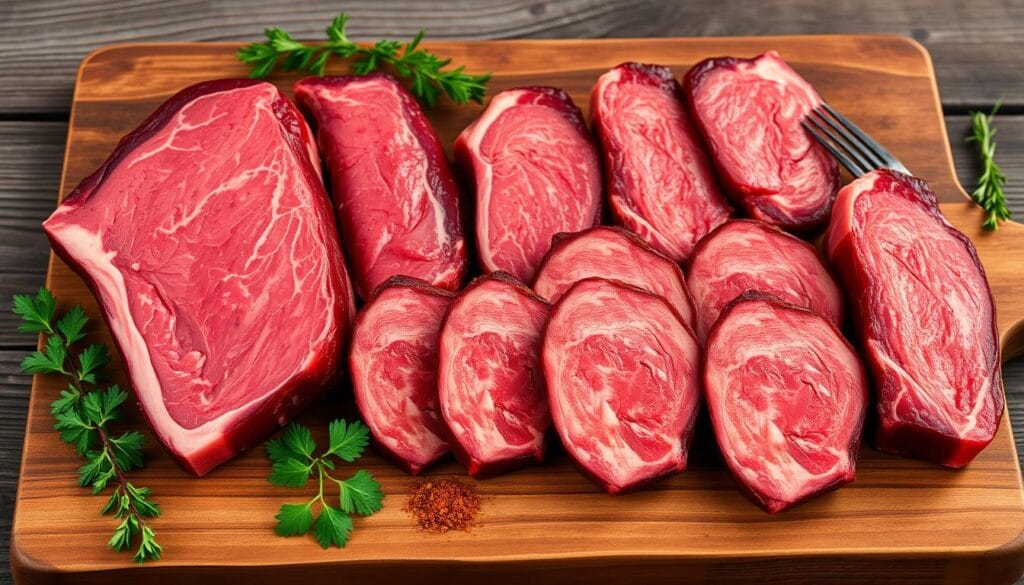
Beef brisket is a tough cut that needs skill to cook right. It comes from the cow’s lower chest. This meat is rich in muscle and needs careful picking and cooking.
Different Grades of Brisket
The USDA divides beef brisket into three main grades:
- Prime Grade: The highest quality with lots of marbling
- Choice Grade: Good marbling and great flavor
- Select Grade: Leaner with less marbling
| Brisket Grade | Marbling | Flavor Intensity | Price Range |
|---|---|---|---|
| Prime | Extensive | Very High | Most Expensive |
| Choice | Moderate | High | Moderate |
| Select | Minimal | Medium | Most Affordable |
Flat Cut vs Point Cut
Knowing about brisket cuts is key to cooking success. The two main cuts have different qualities:
- Flat Cut: Leaner, more even shape
- Point Cut: More marbling, tastes better
How to Choose Quality Brisket
When picking beef brisket, look for these signs of quality:
- Even fat distribution
- Bright red color
- Firm texture
- Little liquid in packaging
“The secret to great brisket starts with selecting the right cut.” – BBQ Pitmaster
By learning about brisket cuts, grades, and how to choose, you’ll be ready to make a delicious barbecue. It will impress anyone who loves meat.
Essential Equipment for Perfect Brisket Preparation
To make a top-notch BBQ brisket, you need the right gear. Professional pitmasters say quality tools are key. They make a big difference in your smoked brisket.
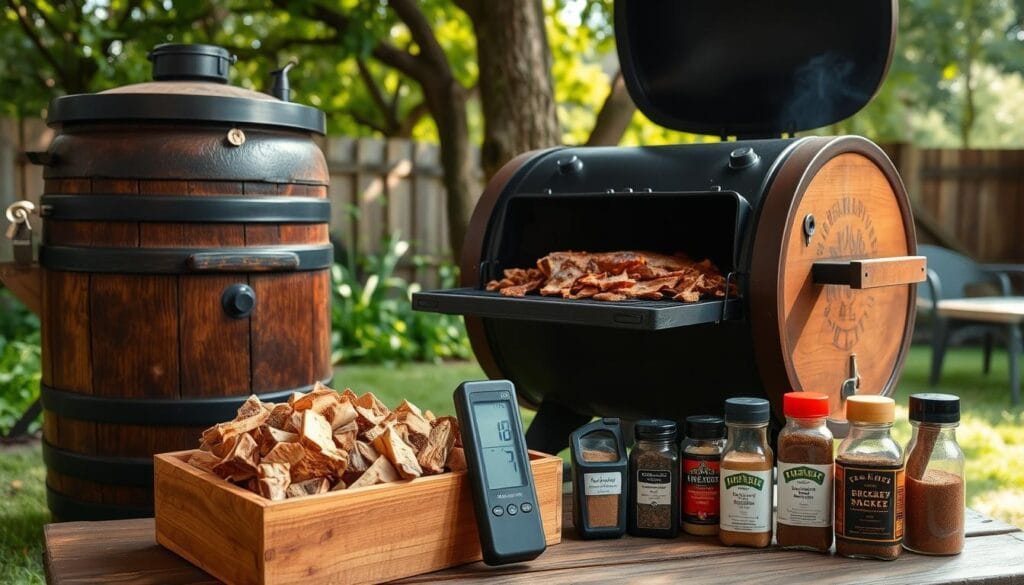
For brisket smoking, you’ll need a few important items. These ensure your brisket turns out great:
- Smoker (offset, vertical, or pellet)
- Reliable meat thermometer
- Heavy-duty cutting board
- Sharp boning knife
- Butcher paper or aluminum foil
- Heat-resistant gloves
Your smoker is the most important piece of brisket equipment. Each type has its own benefits:
| Smoker Type | Pros | Best For |
|---|---|---|
| Offset Smoker | Traditional flavor, large capacity | Experienced BBQ enthusiasts |
| Pellet Smoker | Easy temperature control | Beginners and consistent results |
| Vertical Smoker | Space-efficient, even heating | Home cooks with limited space |
Getting a top-notch digital meat thermometer is vital for BBQ brisket. Precision is key in brisket smoking. You need to track both meat and smoker temperatures accurately.
“The right tools transform cooking from a chore to an art form.” – BBQ Pitmaster
Remember, the right tools and preparation can make your brisket legendary. Choose tools that fit your skill level and cooking style.
Creating the Ultimate Brisket Rub and Seasoning
Making the perfect brisket rub is like an art. It turns good meat into something amazing. Your seasoning is what makes your Texas-style brisket unforgettable.
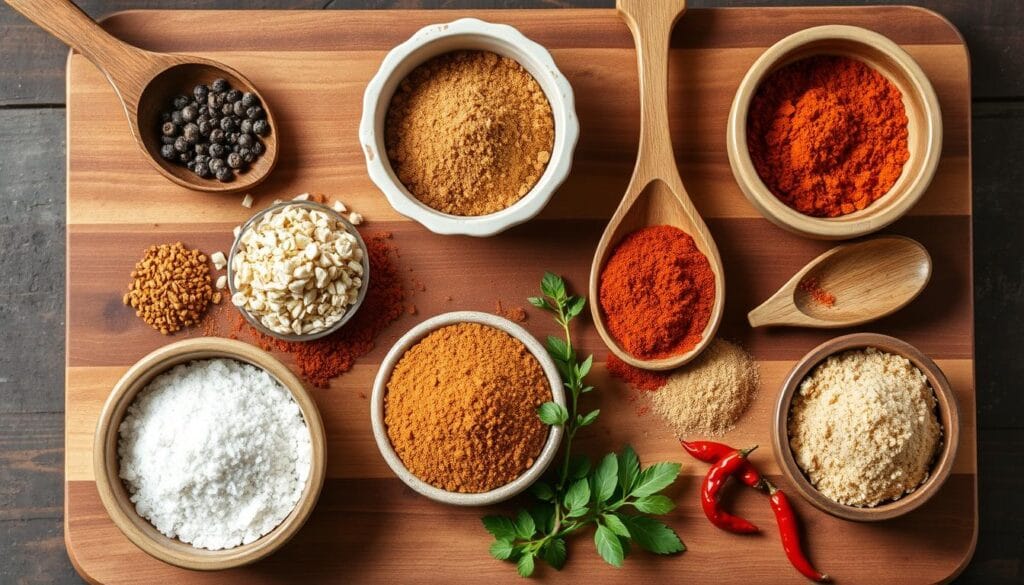
The secret to a great brisket rub is balancing flavors. You want to mix spices that enhance the meat’s taste without taking over.
Classic Texas-Style Rub Recipe
A traditional Texas-style brisket rub uses simple yet powerful ingredients:
- Coarse kosher salt
- Coarse ground black pepper
- Paprika
- Garlic powder
- Chili powder
Alternative Seasoning Combinations
You can also try different flavor mixes:
| Rub Style | Key Ingredients | Flavor Profile |
|---|---|---|
| Spicy Southwest | Chipotle powder, cumin, cayenne | Bold and fiery |
| Sweet and Smoky | Brown sugar, smoked paprika | Caramelized undertones |
| Herb-Infused | Dried thyme, rosemary, oregano | Aromatic and complex |
When and How to Apply Rub
When you put the rub on is key. Here’s how to get the most flavor:
- Put on a lot of rub
- Let it sit for at least 1 hour
- For even more flavor, chill overnight
- Bring it to room temperature before cooking
“A great brisket rub is like a symphony – every ingredient plays a key role in perfect flavor harmony.” – BBQ Pitmaster
Pro tip: Always dry the brisket before rubbing. It helps the seasoning stick better.
Smoking Techniques for Championship-Worthy Brisket
Mastering smoked brisket is more than just grilling meat. It’s an art that needs precision, patience, and skill.
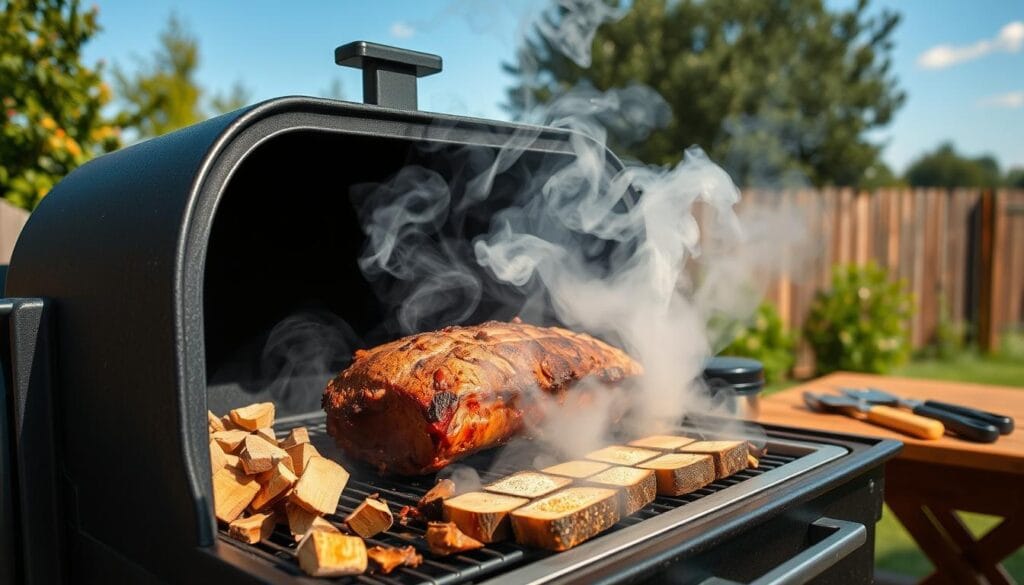
Your journey to making great brisket starts with learning key techniques. These techniques turn a simple cut into a delicious dish. The main goal is to keep the temperature steady and control smoke.
- Low and slow cooking method
- Maintaining steady temperature between 225-250°F
- Using indirect heat for even cooking
- Monitoring internal meat temperature
“Great BBQ brisket isn’t made—it’s carefully crafted.” – Championship Pitmaster
Experts say there are a few key techniques for perfect brisket:
- Prepare your smoker with proper ventilation
- Use a water pan to maintain moisture
- Wrap brisket during cooking to prevent drying
- Allow sufficient resting time after smoking
| Smoking Technique | Key Benefit | Difficulty Level |
|---|---|---|
| Offset Smoking | Even heat distribution | Advanced |
| Vertical Water Smoker | Consistent moisture | Intermediate |
| Pellet Smoker | Precise temperature control | Beginner-Friendly |
Remember, great brisket smoking is about patience and practice. Each technique requires understanding your specific equipment and meat cut.
Temperature Control and Cooking Times Explained
Mastering brisket cooking needs precision and patience. To make a perfect slow-cooked brisket, you must understand temperature and timing. It’s all about watching the brisket’s temperature and knowing how to cook it right.
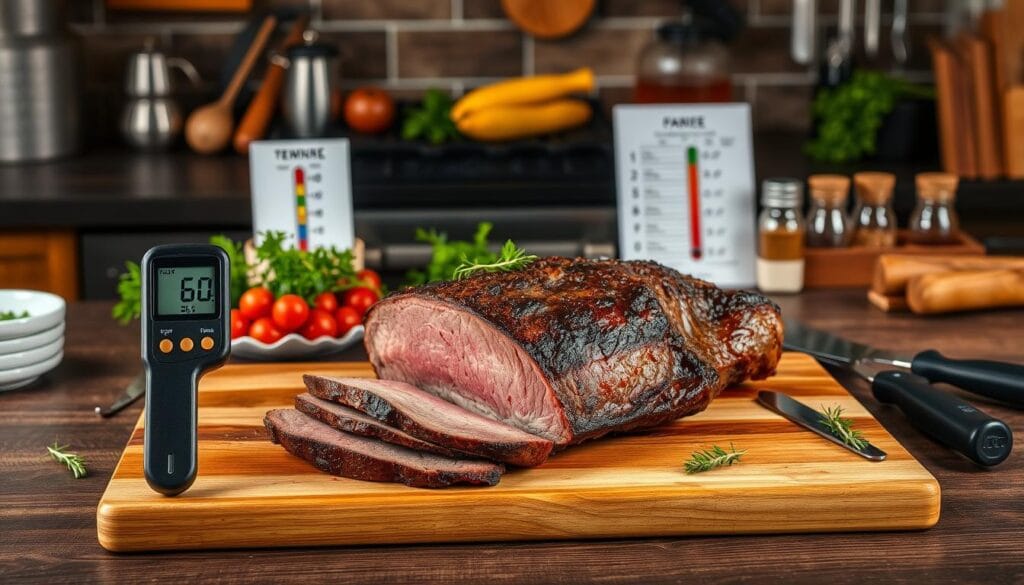
Brisket cooking involves several key temperature stages. Paying close attention to the meat’s internal temperature makes all the difference.
Understanding the Stall Period
When cooking slow-cooked brisket, you’ll hit a snag called the stall period. This happens when the meat’s temperature stops rising, usually between 150-165°F. Here’s what’s going on:
- Moisture evaporates from the meat’s surface
- Cooling effect temporarily stops temperature rise
- Can last 2-4 hours depending on brisket size
Target Internal Temperatures
Getting the brisket temperature right is key for tender, tasty meat. Follow this temperature guide:
- Start cooking at 225-250°F
- Aim for internal temperature of 203°F for perfect tenderness
- Use a reliable meat thermometer for accuracy
Time Management Tips
Brisket cooking needs careful planning. Expect about 1-1.5 hours of cooking time per pound of meat. Patience is essential for a delicious brisket.
“Low and slow is the golden rule of brisket cooking” – BBQ Pitmaster
Remember, every brisket is different. Things like meat thickness, fat content, and smoker consistency affect cooking time and temperature.
Mastering the Art of Wood Selection for Smoking
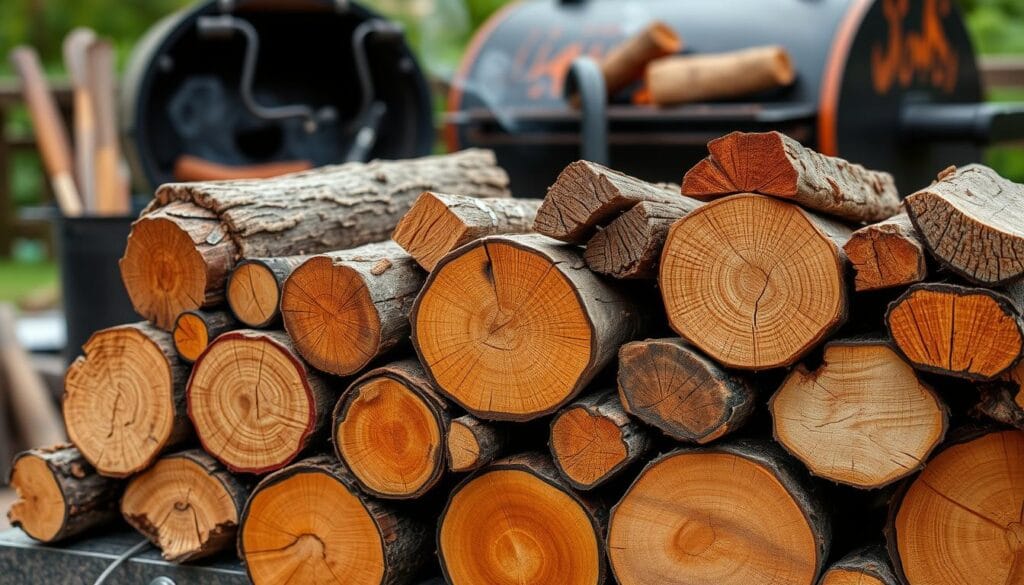
Choosing the right wood is key to a great smoked brisket. The wood you pick can change the flavor of your BBQ brisket. It can turn a simple meal into a special experience.
“The wood you choose is like a painter’s palette – it adds depth, character, and nuance to your smoked brisket.” – BBQ Pitmaster
Each wood gives a unique taste to your brisket. Knowing these flavors helps you get the perfect smoky taste. This taste should match the meat’s natural flavor.
- Mild Woods
- Apple: Sweet, subtle flavor
- Cherry: Mild, fruity undertones
- Strong Woods
- Mesquite: Intense, bold flavor
- Hickory: Rich, bacon-like taste
Think about the brisket’s strong flavor when picking wood. Stronger woods can hide the brisket’s taste. Milder woods can add flavor without taking over.
| Wood Type | Flavor Profile | Best For |
|---|---|---|
| Oak | Medium, balanced | Classic Texas-style brisket |
| Pecan | Sweet, nutty | Mild smoked brisket |
| Post Oak | Light, clean | Competition-style smoking |
Pro tip for brisket smoking: Mix wood types for complex flavors. Oak and fruit woods together make a smoked brisket that wows BBQ fans.
The Science Behind the Perfect Smoke Ring
Smoking brisket isn’t just about the taste—it’s also about the science. The smoke ring is a chemical wonder that turns your meat into a work of art. Knowing how it works can make you a pro at smoking brisket.
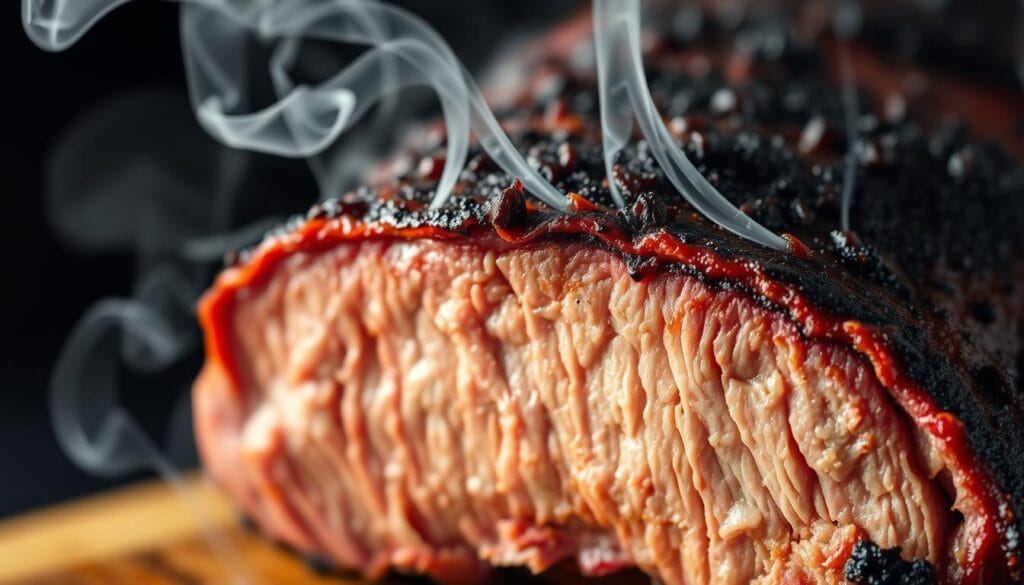
The smoke ring is that pinkish-red layer on smoked meat. It’s made when wood smoke’s nitrogen meets meat proteins. This creates the color that barbecue fans love.
Chemical Reactions During Smoking
When you start smoking brisket, some important chemical reactions happen:
- Nitric oxide from wood smoke gets into the meat.
- Myoglobin proteins mix with nitrogen compounds.
- How hot it is and how thick the smoke are key.
Factors Affecting Smoke Ring Formation
Getting the perfect smoke ring takes a few things:
| Factor | Impact on Smoke Ring |
|---|---|
| Wood Type | Determines nitrogen compound concentration |
| Meat Temperature | Influences protein binding efficiency |
| Smoke Density | Controls nitrogen penetration depth |
“The smoke ring isn’t just about appearance—it’s a testament to your mastery of brisket smoking techniques.”
Getting the smoke ring right takes time, patience, and practice. It shows you know how to handle temperature, smoke, and meat. Even though it doesn’t affect taste, a good smoke ring shows your skill.
Slicing and Serving Your Brisket
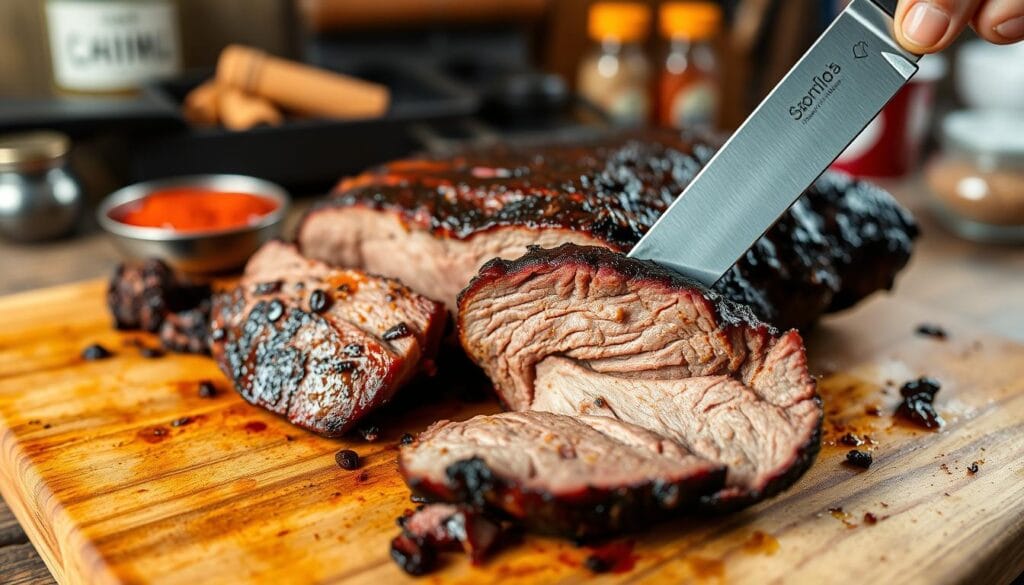
Mastering beef brisket slicing is an art that sets apart amateur grillers from true BBQ brisket experts. The way you cut your meat greatly affects its tenderness, presentation, and overall eating experience.
“A perfectly sliced brisket tells a story of patience, skill, and culinary passion.” – BBQ Pitmaster
To achieve professional-grade brisket slicing, you’ll need a few essential tools and techniques. Sharp knives are key for clean, precise cuts that highlight the meat’s beautiful texture.
Brisket Slicing Techniques
- Use a long, sharp knife with a narrow blade
- Cut against the grain for maximum tenderness
- Slice brisket when it’s slightly warm, not hot or cold
- Aim for consistent slice thickness (about 1/4 inch)
Understanding the grain direction is critical when slicing beef brisket. The grain refers to the muscle fiber alignment, which varies between the flat and point cuts of the brisket.
Grain Direction Guide
| Brisket Cut | Grain Direction | Slicing Recommendation |
|---|---|---|
| Flat Cut | Straight, uniform | Perpendicular to muscle lines |
| Point Cut | More irregular | Careful identification of muscle fibers |
When serving your BBQ brisket, presentation matters. Arrange slices slightly overlapping on a warm platter, allowing the rich bark and tender meat to shine. Pair with classic sides like coleslaw, pickles, and Texas-style beans to complete your meal.
Storing and Reheating Leftover Brisket
Enjoying a delicious beef brisket meal is great. But knowing how to store and reheat leftovers is key. This keeps the flavor and tenderness perfect.
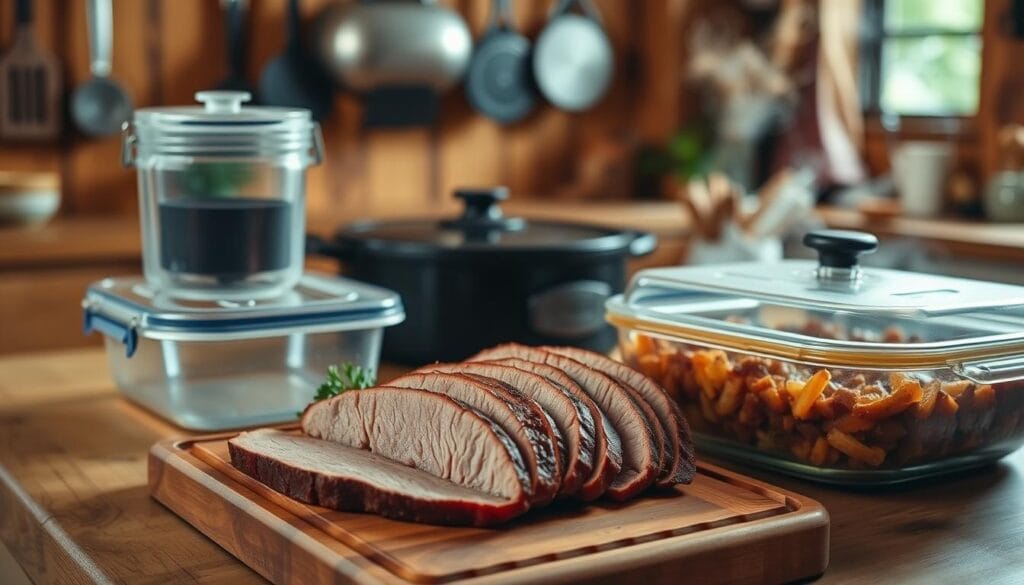
Proper Storage Methods
Storing leftover brisket right is important. Here are the steps to keep it fresh and tasty:
- Cool the brisket to room temperature within 2 hours of cooking
- Slice the meat before storing to prevent drying out
- Store in airtight containers or wrapped tightly in aluminum foil
- Refrigerate for up to 4 days
- Freeze for extended storage up to 3 months
Reheating Techniques
Reheating brisket needs care. You want to keep it moist and tender.
| Reheating Method | Temperature | Moisture Technique |
|---|---|---|
| Oven | 275°F | Add beef broth or au jus |
| Slow Cooker | Low setting | Include small amount of liquid |
| Microwave | 50% power | Cover with damp paper towel |
“The secret to great reheated brisket is low and slow heat with added moisture.” – BBQ Pitmaster
By using these storage and reheating tips, your leftover beef brisket will taste just as good as when it was first cooked.
Common Brisket Cooking Mistakes to Avoid
Perfecting beef brisket takes skill and knowledge. Many home cooks make mistakes that turn a great meal into a tough, dry one. Knowing these common mistakes can help you improve your BBQ skills.
Brisket cooking needs patience and precision. Here are the most important mistakes to avoid:
- Skipping the Trim: Not trimming excess fat stops smoke from penetrating and cooking evenly
- Rushing the Cooking Process: Brisket needs low and slow cooking to soften tough tissues
- Inconsistent Temperature Control: Fluctuating smoker temperatures lead to uneven cooking
- Not Allowing Proper Resting Time: Cutting into brisket too soon loses precious moisture
“The difference between good and great brisket is attention to detail.” – Award-Winning Pitmaster
Experts recommend keeping the smoker at 225-250°F and using a meat thermometer. The internal temperature should hit about 203°F for tenderness.
Understanding these brisket cooking tips can make your BBQ stand out. With practice, patience, and careful technique, your beef brisket will be the highlight of any meal.
Conclusion
Mastering beef brisket is an art that needs technique, patience, and passion. You’ve grown from picking the right meat to mastering smoking. Making a delicious brisket takes practice, precision, and a love for learning.
The secret to great brisket recipes is knowing how to prepare, season, and cook it. Whether you grill at home or dream of being a pitmaster, you now have the skills. You can turn a tough cut into a tender, tasty dish that will wow everyone.
Every brisket is different, and your skills will get better with each try. Keep learning, try new woods, rubs, and ways to cook. Your confidence in making beef brisket will grow, making it a fun journey to share.
With what you’ve learned, you’re ready for your next brisket challenge. Light up the smoker, trust yourself, and enjoy making a BBQ brisket that will be the star of any meal.

